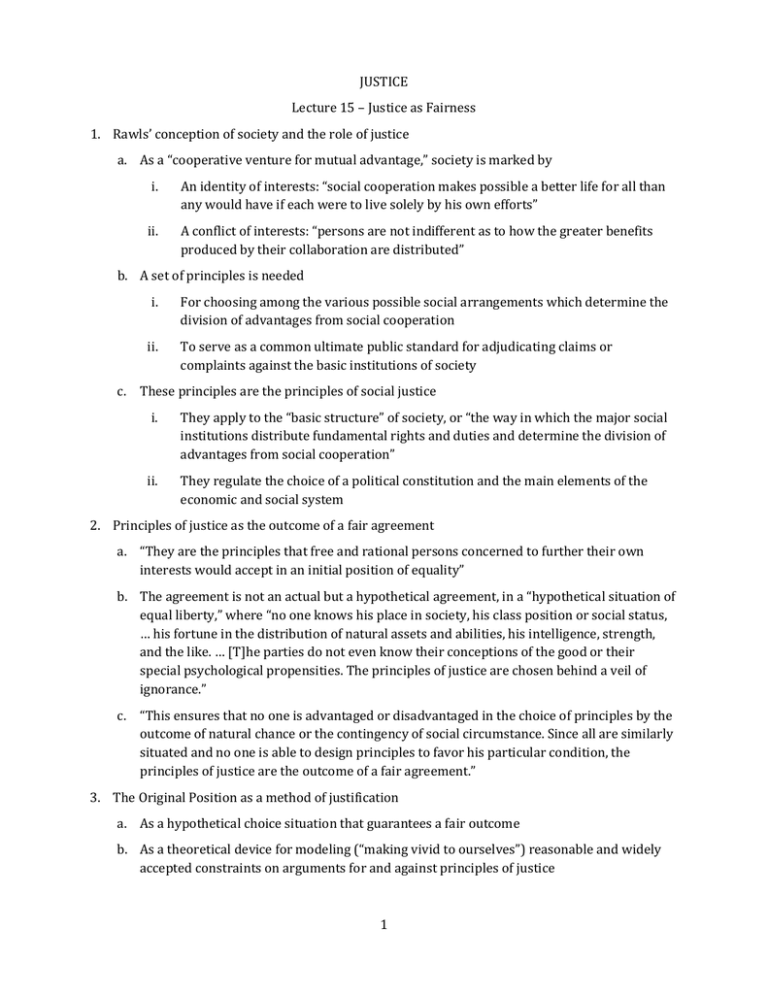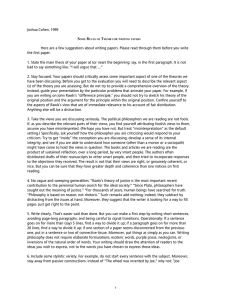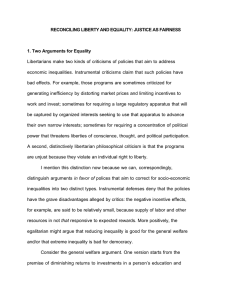JUSTICE Lecture 15 – Justice as Fairness
advertisement

JUSTICE Lecture 15 – Justice as Fairness 1. Rawls’ conception of society and the role of justice a. As a “cooperative venture for mutual advantage,” society is marked by i. An identity of interests: “social cooperation makes possible a better life for all than any would have if each were to live solely by his own efforts” ii. A conflict of interests: “persons are not indifferent as to how the greater benefits produced by their collaboration are distributed” i. For choosing among the various possible social arrangements which determine the division of advantages from social cooperation b. A set of principles is needed ii. To serve as a common ultimate public standard for adjudicating claims or complaints against the basic institutions of society i. They apply to the “basic structure” of society, or “the way in which the major social institutions distribute fundamental rights and duties and determine the division of advantages from social cooperation” c. These principles are the principles of social justice ii. They regulate the choice of a political constitution and the main elements of the economic and social system 2. Principles of justice as the outcome of a fair agreement a. “They are the principles that free and rational persons concerned to further their own interests would accept in an initial position of equality” b. The agreement is not an actual but a hypothetical agreement, in a “hypothetical situation of equal liberty,” where “no one knows his place in society, his class position or social status, … his fortune in the distribution of natural assets and abilities, his intelligence, strength, and the like. … [T]he parties do not even know their conceptions of the good or their special psychological propensities. The principles of justice are chosen behind a veil of ignorance.” c. “This ensures that no one is advantaged or disadvantaged in the choice of principles by the outcome of natural chance or the contingency of social circumstance. Since all are similarly situated and no one is able to design principles to favor his particular condition, the principles of justice are the outcome of a fair agreement.” 3. The Original Position as a method of justification a. As a hypothetical choice situation that guarantees a fair outcome b. As a theoretical device for modeling (“making vivid to ourselves”) reasonable and widely accepted constraints on arguments for and against principles of justice 1 c. As a method that yields principles of justice that account for our “considered judgments” of justice d. The Original Position as an instance of the method of “reflective equilibrium,” not an alternative to it 4. The two principles that Rawls thinks would be chosen in the Original Position: a. A preliminary statement: i. ii. iii. First Principle: “Each person is to have an equal right to the most extensive scheme of equal basic liberties compatible with a similar scheme of liberties for others.” Second Principle: “Social and economic inequalities are to be arranged so that they are both (a) reasonably expected to be to everyone’s advantage and (b) attached to positions open to all.” Priority Rules: First Principle takes priority over the Second Principle, and in applying the Second Principle the requirement that positions be open to all takes priority over ensuring that socioeconomic inequalities benefit everyone. b. How are we to understand the phrases “open to all” and “to everyone’s advantage” in interpreting the requirements of the Second Principle? 5. Three alternative interpretations of the Second Principle: a. The System of Natural Liberty i. ii. iii. “To everyone’s advantage” = Principle of efficiency (Pareto optimality) “Open to all” = Non-discrimination (“careers open to talent”) Institutional implications: 1. Distribution of income and wealth determined by a free market 2. Against a background of legally enforced non-discrimination 3. And a constitutional political order compatible with the First Principle b. Rawls’ objection to the System of Natural Liberty i. ii. “Since there is no effort to preserve an equality, or similarity, of social conditions except insofar as this is necessary to preserve the requisite background institutions,” the distribution of income and wealth will be the “cumulative effect of prior distributions of natural assets—that is, natural talents and abilities—as these have been developed or left unrealized, and their use favored or disfavored over time by such chance contingencies as accident and good fortune.” “Intuitively, the most obvious injustice of the system of natural liberty is that it permits distributive shares to be improperly influenced by these factors so arbitrary from a moral point of view.” c. The Liberal Equality interpretation i. Tries to correct for this by replacing “careers open to talents” with “Fair Equality of Opportunity”: 2 1. “those who are at the same level of talent and ability, and have the same willingness to use them, should have the same prospects of success regardless of their initial place in the social system, that is, irrespective of the income class into which they are born.” 2. Institutional implications: a. A framework of political, legal and social institutions which, subject to the requirements of the First Principle: i. ii. prevents excessive accumulations of property and wealth, detrimental to Fair Equality of Opportunity provides equal opportunities for education for all, regardless of family or class origins d. Rawls’ objection to Liberal Equality i. “even if it works to perfection in eliminating the influence of social contingencies, it still permits the distribution of wealth and income to be determined by the natural distribution of abilities and talents,” and this is “arbitrary from a moral point of view. There is no more reason to permit the distribution of income and wealth to be settled by the distribution of natural assets than by historical and social fortune.” ii. Moreover, Fair Equality of Opportunity can be only imperfectly realized in a market society “at least as long as some form of the family exists.” i. “recognizes this fact” (i.e., that Fair Equality of Opportunity can be only imperfectly realized in a market society that also has the institution of the family) iii. How? By replacing the Principle of Efficiency with the Difference Principle as the criterion for when social and economic inequalities are to “everyone’s advantage” and thus permissible e. Democratic Equality—Rawls’ preferred interpretation of the Second Principle— ii. “and also mitigates the arbitrary effects of the natural lottery itself” 1. Difference Principle: Social and economic inequalities must be to the greatest possible benefit of the least advantaged group in society iv. 2. “Inequality is permissible only if lowering it would make the working class even more worse off” Institutional implication (in addition to Fair Equality of Opportunity): A “social minimum” must be instituted and maintained at the highest sustainable level 6. Rawls’ two arguments for his Two Principles of Justice (the Democratic Equality interpretation) a. The argument from “inside” the Original Position: the Two Principles are the principles that would be chosen in the Original Position, a choice situation that guarantees a fair outcome i. The unusual conditions in the Original Position warrant use of the “maximin” rule (from the available alternatives, choose the alternative with the highest minimum) 3 1. There is no information that can be used to estimate the probability of being in a given social position a. [Why not? This restriction on information intended to model a reasonable constraint on arguments about justice (?): the justice of a given way of assigning rights and goods to various social positions does not depend on the numbers of persons in those positions] 2. It is possible to assure oneself of a satisfactory minimum by choosing the Two Principles 3. The other alternatives all have potential outcomes one could not accept a. The agreement determines your entire life prospects and is final (no way to offset losses with future choices or gambles) b. The “strains of commitment” would be too great to bear under the worst outcomes possible under (e.g.) Utilitarianism c. Impossibility of agreeing to (e.g.) the Principle of Utility in “good faith” i. [Do these considerations apply with the same force to the choice of other plausible principles? Consider (a) Principle of Equal Basic Liberties with lexical priority, plus (b) Principle of Utility, constrained by a social minimum that is adequate but significantly below the maximum sustainable level] a. The larger “reflective equilibrium” argument: the Original Position and the Two Principles it yields reflect reasonable constraints on arguments for principles of justice; and the Two Principles account for our “considered judgments” of justice, and extend them in ways that on reflection seem correct i. The hypothetical “contract”: models the constraint that principles of justice must be justifiable to each person (compare Utilitarianism, which may impose large individual sacrifices) ii. The “veil of ignorance”: the mere fact that a principle would assign greater benefits to someone with your class origins or natural talents or aims in life is not—by itself—a reason for society to adopt that principle iii. The first principle requiring equal basic liberties accounts for (e.g.) the considered judgments that slavery and religious persecution are unjust iv. Fair Equality of Opportunity accounts for (e.g.) the judgments that racial and sexual discrimination are unjust, and that unequal life chances deriving from inherited class positions are unjust v. The Difference Principle reflects (e.g.) the judgments that no one deserves greater rewards merely because he was born with a scarce talent but that there is no reasonable objection to inequalities that make everyone better off 7. Does Rawls’ theory of justice move us closer to reflective equilibrium? Rawls, John. A Theory of Justice. Belknap Press of Harvard University Press, 2005. All rights reserved. This content is excluded from our Creative Commons license. For more information, see http://ocw.mit.edu/fairuse. 4 MIT OpenCourseWare http://ocw.mit.edu 24.04J / 17.01J Justice Spring 2012 For information about citing these materials or our Terms of Use, visit: http://ocw.mit.edu/terms.





